英语 造 词 法
12种英语构词方法
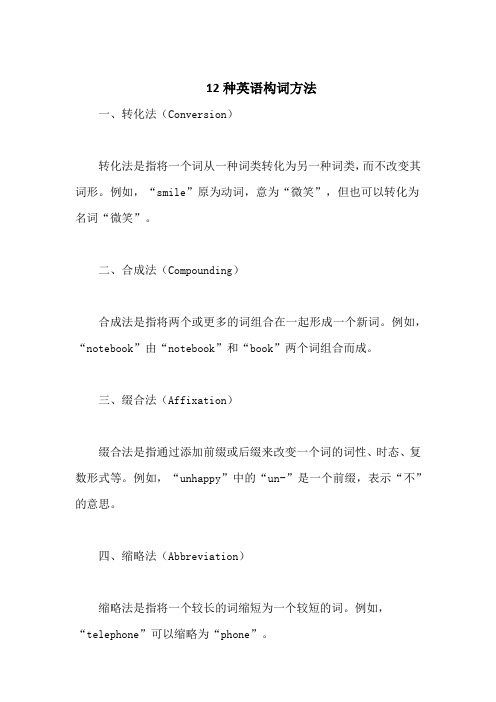
12种英语构词方法一、转化法(Conversion)转化法是指将一个词从一种词类转化为另一种词类,而不改变其词形。
例如,“smile”原为动词,意为“微笑”,但也可以转化为名词“微笑”。
二、合成法(Compounding)合成法是指将两个或更多的词组合在一起形成一个新词。
例如,“notebook”由“notebook”和“book”两个词组合而成。
三、缀合法(Affixation)缀合法是指通过添加前缀或后缀来改变一个词的词性、时态、复数形式等。
例如,“unhappy”中的“un-”是一个前缀,表示“不”的意思。
四、缩略法(Abbreviation)缩略法是指将一个较长的词缩短为一个较短的词。
例如,“telephone”可以缩略为“phone”。
五、逆生法(Backformation)逆生法是指将一个较长的词缩短为一个较短的词,并添加一个后缀来恢复原词的完整形式。
例如,“telecast”可以逆生为“broadcast”。
六、拟声法(Onomatopoeia)拟声法是指模仿声音来创造新词。
例如,“clang”模仿了金属碰撞的声音。
七、缀词法(Clipping)缀词法是指将一个词的前部分或后部分去掉,只保留中间部分。
例如,“ advertisement”可以缀为“ad”。
八、首字母缩写法(Acronymy)首字母缩写法是指将一组词的首字母组合成一个新词。
例如,“NATO”是“North Atlantic Treaty Organization”的首字母缩写。
九、混成法(Blending)混成法是指将两个或更多的词的部分混合在一起形成一个新词。
例如,“spaghetti”由“spaghetti”和“bottle”两个词混合而成。
十、词类转换法(Word Class Conversion)词类转换法是指将一个词从一种词类转换为另一种词类,同时改变其词形。
例如,“smile”可以转换为名词“smile”。
英语单词造词原理
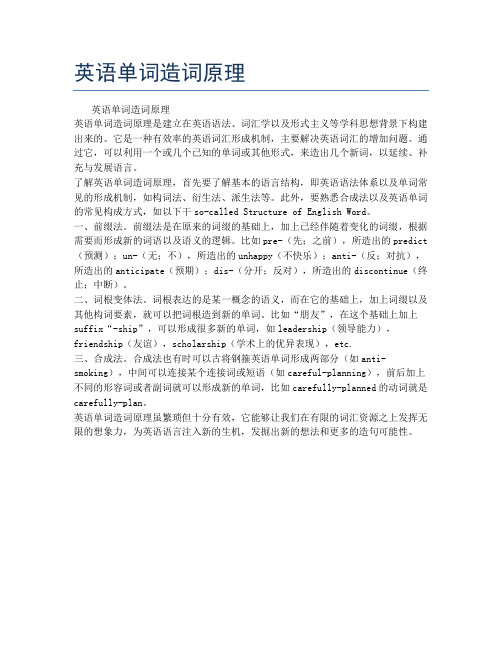
英语单词造词原理英语单词造词原理英语单词造词原理是建立在英语语法、词汇学以及形式主义等学科思想背景下构建出来的。
它是一种有效率的英语词汇形成机制,主要解决英语词汇的增加问题。
通过它,可以利用一个或几个已知的单词或其他形式,来造出几个新词,以延续、补充与发展语言。
了解英语单词造词原理,首先要了解基本的语言结构,即英语语法体系以及单词常见的形成机制,如构词法、衍生法、派生法等。
此外,要熟悉合成法以及英语单词的常见构成方式,如以下干so-called Structure of English Word。
一、前缀法。
前缀法是在原来的词缀的基础上,加上已经伴随着变化的词缀,根据需要而形成新的词语以及语义的逻辑。
比如pre-(先;之前),所造出的predict (预测);un-(无;不),所造出的unhappy(不快乐);anti-(反;对抗),所造出的anticipate(预期);dis-(分开;反对),所造出的discontinue(终止;中断)。
二、词根变体法。
词根表达的是某一概念的语义,而在它的基础上,加上词缀以及其他构词要素,就可以把词根造到新的单词。
比如“朋友”,在这个基础上加上suffix“-sh ip”,可以形成很多新的单词,如leadership(领导能力),friendship(友谊),scholarship(学术上的优异表现),etc.三、合成法。
合成法也有时可以古将钢箍英语单词形成两部分(如anti-smoking),中间可以连接某个连接词或短语(如careful-planning),前后加上不同的形容词或者副词就可以形成新的单词,比如carefully-planned的动词就是carefully-plan。
英语单词造词原理虽繁琐但十分有效,它能够让我们在有限的词汇资源之上发挥无限的想象力,为英语语言注入新的生机,发掘出新的想法和更多的造句可能性。
谈谈英语构词法之合成法
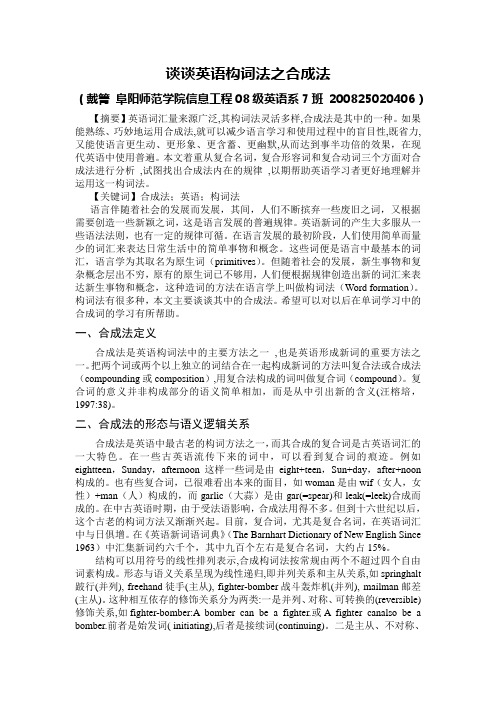
谈谈英语构词法之合成法(戴箐阜阳师范学院信息工程08级英语系7班 200825020406)【摘要】英语词汇量来源广泛,其构词法灵活多样,合成法是其中的一种。
如果能熟练、巧妙地运用合成法,就可以减少语言学习和使用过程中的盲目性,既省力,又能使语言更生动、更形象、更含蓄、更幽默,从而达到事半功倍的效果,在现代英语中使用普遍。
本文着重从复合名词,复合形容词和复合动词三个方面对合成法进行分析,试图找出合成法内在的规律,以期帮助英语学习者更好地理解并运用这一构词法。
【关键词】合成法;英语;构词法语言伴随着社会的发展而发展,其间,人们不断摈弃一些废旧之词,又根据需要创造一些新颖之词,这是语言发展的普遍规律。
英语新词的产生大多服从一些语法法则,也有一定的规律可循。
在语言发展的最初阶段,人们使用简单而量少的词汇来表达日常生活中的简单事物和概念。
这些词便是语言中最基本的词汇,语言学为其取名为原生词(primitives)。
但随着社会的发展,新生事物和复杂概念层出不穷,原有的原生词已不够用,人们便根据规律创造出新的词汇来表达新生事物和概念,这种造词的方法在语言学上叫做构词法(Word formation)。
构词法有很多种,本文主要谈谈其中的合成法。
希望可以对以后在单词学习中的合成词的学习有所帮助。
一、合成法定义合成法是英语构词法中的主要方法之一,也是英语形成新词的重要方法之一。
把两个词或两个以上独立的词结合在一起构成新词的方法叫复合法或合成法(compounding或composition),用复合法构成的词叫做复合词(compound)。
复合词的意义并非构成部分的语义简单相加,而是从中引出新的含义(汪榕培,1997:38)。
二、合成法的形态与语义逻辑关系合成法是英语中最古老的构词方法之一,而其合成的复合词是古英语词汇的一大特色。
在一些古英语流传下来的词中,可以看到复合词的痕迹。
例如eightteen,Sunday,afternoon这样一些词是由eight+teen,Sun+day,after+noon 构成的。
浅析英语构词法
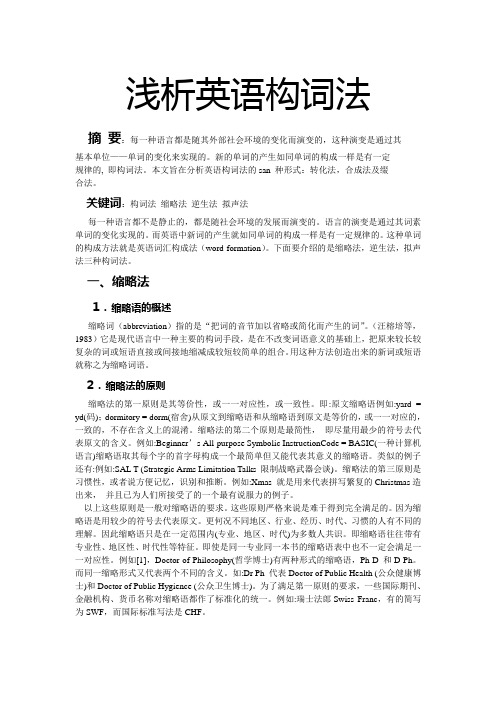
浅析英语构词法摘要:每一种语言都是随其外部社会环境的变化而演变的,这种演变是通过其基本单位——单词的变化来实现的。
新的单词的产生如同单词的构成一样是有一定规律的, 即构词法。
本文旨在分析英语构词法的san 种形式:转化法,合成法及缀合法。
关键词:构词法缩略法逆生法拟声法每一种语言都不是静止的,都是随社会环境的发展而演变的。
语言的演变是通过其词素单词的变化实现的。
而英语中新词的产生就如同单词的构成一样是有一定规律的。
这种单词的构成方法就是英语词汇构成法(word-formation)。
下面要介绍的是缩略法,逆生法,拟声法三种构词法。
一、缩略法1.缩略语的概述缩略词(abbreviation)指的是“把词的音节加以省略或简化而产生的词”。
(汪榕培等,1983)它是现代语言中一种主要的构词手段,是在不改变词语意义的基础上,把原来较长较复杂的词或短语直接或间接地缩减成较短较简单的组合。
用这种方法创造出来的新词或短语就称之为缩略词语。
2.缩略法的原则缩略法的第一原则是其等价性,或一一对应性,或一致性。
即:原文缩略语例如:yard = yd(码);dormitory = dorm(宿舍)从原文到缩略语和从缩略语到原文是等价的,或一一对应的,一致的,不存在含义上的混淆。
缩略法的第二个原则是最简性,即尽量用最少的符号去代表原文的含义。
例如:Beginner’s All-purpose Symbolic InstructionCode = BASIC(一种计算机语言)缩略语取其每个字的首字母构成一个最简单但又能代表其意义的缩略语。
类似的例子还有:例如:SAL T (Strategic Arms Limitation Talks 限制战略武器会谈)。
缩略法的第三原则是习惯性,或者说方便记忆,识别和推断。
例如:Xmas 就是用来代表拼写繁复的Christmas造出来,并且已为人们所接受了的一个最有说服力的例子。
以上这些原则是一般对缩略语的要求。
造词法破解英语词汇
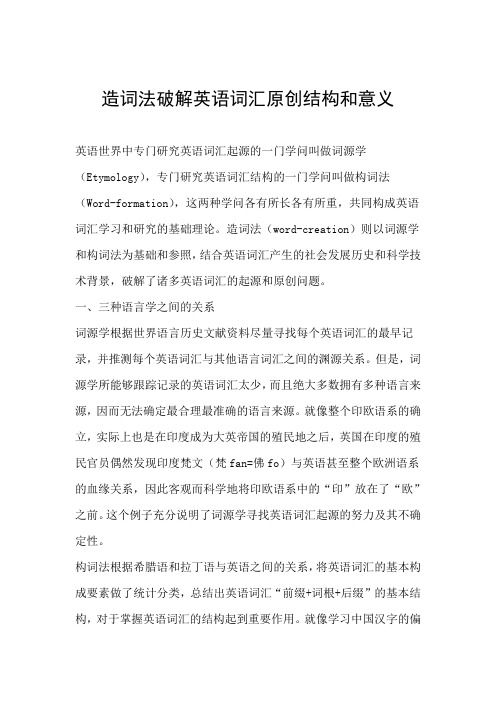
造词法破解英语词汇原创结构和意义英语世界中专门研究英语词汇起源的一门学问叫做词源学(Etymology),专门研究英语词汇结构的一门学问叫做构词法(Word-formation),这两种学问各有所长各有所重,共同构成英语词汇学习和研究的基础理论。
造词法(word-creation)则以词源学和构词法为基础和参照,结合英语词汇产生的社会发展历史和科学技术背景,破解了诸多英语词汇的起源和原创问题。
一、三种语言学之间的关系词源学根据世界语言历史文献资料尽量寻找每个英语词汇的最早记录,并推测每个英语词汇与其他语言词汇之间的渊源关系。
但是,词源学所能够跟踪记录的英语词汇太少,而且绝大多数拥有多种语言来源,因而无法确定最合理最准确的语言来源。
就像整个印欧语系的确立,实际上也是在印度成为大英帝国的殖民地之后,英国在印度的殖民官员偶然发现印度梵文(梵fan=佛fo)与英语甚至整个欧洲语系的血缘关系,因此客观而科学地将印欧语系中的“印”放在了“欧”之前。
这个例子充分说明了词源学寻找英语词汇起源的努力及其不确定性。
构词法根据希腊语和拉丁语与英语之间的关系,将英语词汇的基本构成要素做了统计分类,总结出英语词汇“前缀+词根+后缀”的基本结构,对于掌握英语词汇的结构起到重要作用。
就像学习中国汉字的偏旁部首一样,构词法成为英语初学者的入门工具。
但是,构成法只解决了词汇结构或者词汇形状问题,并没有解决为什么特定结构在一起就形成了特定词汇的特种意义。
在中国,有一本叫做《说文解字》的古书,对汉字不同结构组合在一起的原创意义进行了初步探索和分析;但是,构词法并不具备《说文解字》的功能,更加重要的是构词法词缀过多而且分类和解释并不科学,因而,构词法对于许多中国学者而言并不具备理解英语词汇并简化记忆的功能。
造词法以英语词汇产生的社会发展和科学技术为背景,尊重词源学与逻辑学之间的相互印证,遵循统计学和语言学(包括词源学和构词法)的基本原理,探索每一个英语词汇的“音形义”创造过程以及诸多英语词族之间的本质联系,最终从英语词汇快速增长的语言现象中归纳出造词法的四项基本原则和造词公式,在汉语和英语之间建立了直接的思维转换桥梁。
汉语与英语造词法比较
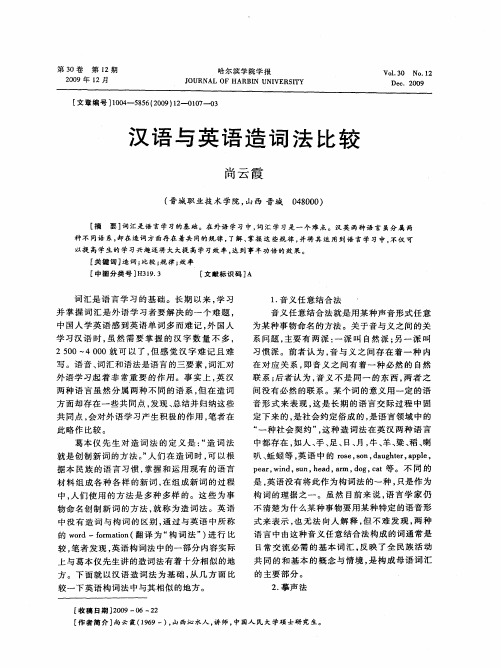
第 1 2期
哈 尔 滨 学 院学 报
J OURN AL OF HAR N UNI ERS T BI V IY
Vo . O No. 2 13 1 De C.20 09
20 0 9年 l 2月
[ 章 编 号 ] 04 5 5 (09 l- 0 0 _ o 文 10 - 8 6 2 0 ) 2- l7 3
18 0
哈 尔 滨 学 院 学 报
20 09钷
摹声 法就是 用 人类 语 言 的语 音 形 式 , 某 对 种声音加 以摹 拟和改 造 , 而创制 新词 的方 法 。 从 这种 方 法汉语 中认 为是 一 种造 词 法 , 语 中也 英
只把它 当作造 词 的理 据之 一 。如 汉语 中的两种
汉 语 与 英 语 造 词 法 比较
尚云 霞
( 晋城 职业技 术 学院 ,ቤተ መጻሕፍቲ ባይዱ山西 晋城
【 摘
08 O ) 4O O
要 】 汇是 语 言 学 习 的基 础 。在 外 语 学 习 中 , 汇 学 习是 一 个 难 点 。 汉 英 两 种 语 言 虽 分 属 两 词 词
种 不 同语 系 , 在 造 词 方 面存 在 着共 同 的规 律 , 却 了解 、 握 这 些 规 律 , 掌 并将 其 运 用 到 语 言 学 习 中 ,  ̄ - 不 t* l f
1 音 义任 意结 合 法 . 音义 任 意结合 法 就是用 某 种声音 形式 任 意 为 某种 事 物命 名 的方法 。关 于 音与义 之 间的关
系 问题 , 主要 有 两 派 : 派 叫 自然 派 ; 一 另一 派 叫
并 掌 握词 汇是 外 语 学 习者 要 解决 的一 个难 题 , 中 国人 学 英 语 感 到英 语 单 词 多而 难 记 , 国人 外 学 习汉语 时 , 然 需 要 掌握 的 汉 字 数 量 不 多 , 虽
英语词汇构词法汇总

用构词法猜单词或造单词英语构词法在诸多的构词法中,最常见的有转化(conversion)、合成(composition)、派生(derivation)三种构词法。
现将三种主要的构词法逐一作个基本介绍。
以此为基础举一反三,可解决词汇量的不足的问题。
合成将两个或两个以上独立的单词按一定的次序排列而成新词的方法称为合成法。
由合成法构成的词叫复合词(compound words)。
复合词在英语中是比较活跃的,涉及面相当广泛,涵盖了政治、军事、经济、文化、科技等领域。
对大多数复合词,我们一般都能从其构成分中猜出其词义,如:birth-control, whiteboard, banknote, faultfinding, manservant等;但必须特别注意的是,有些复合词的词义并不是其中每个字的词义的简单相加,而是从中引用全新的含义,因此,切不可望文生义。
例如:touch-me not(凤仙花),blueblood(贵族出身),blue-moon (不可能有的东西)blackmail(勒索),old-line(老资格),green horn(新手),shorthand(速记),rat race(你死我活的竟争)等。
科技新词大都这样构成的,请从阅读文本中找出来补充:转化由一个词类转化为另一个词类,这种构词法叫转化法,也称为零位派生法。
主要特点是某类词不经过任何变化而用做另一类词。
例如:She likes playing bowling very much. Like (动词)It looks like rain. (动词介词)I don’t welcome Tom and the like. (动词名词),意为“之类”。
They are as like as two peas. like (动词-形容词)If you agree, please circle the letter. (名词-动词)Do you know who is going to chair the conference? Chair(名词-动词),7.Let me have a try. Nice try. (动词-名词)He is about the same build as me. ( 动词-名词)This is a decision move. (名词) Move! (动词)Women have equal say in everything. (动词—>名词)The room can seat a thousand people. ( 名词动词)It pictures the life of our family before the year of 2000. (名词动词)The work must be properly timed. (名词动词)The Pearl River empties into the South China Sea. (形容词-动词)My mum has been always backing me up. ( 名词-动词)派生派生是英语的主要构词方法。
(完整版)英语基本构词法

英语基本构词法英语最基本的构词法(word formation)有三种:派生(derivation)、合成(compounding)和转化(conversion)。
利用构词法记忆单词,可以记忆成串,举一反三。
Ⅰ。
派生法派生词缀和词根结合,或者粘着词根和粘着词根结合构成单词的方法,叫做派生法(derivation),也称作缀词法。
用派生法构成的词叫做派生词(derivative).派生词的词缀法是英语构词法中最活跃的一种,在英语构词的历史上发挥极其重要的作用。
另外,这种构词法也是我们可以发挥能动性借以扩大词汇量的一种构词法。
词缀分为前缀和后缀两种。
A.前缀1.表示“否定”、“相反”意义的前缀:de— decrease减少;decentralize分散;degrade降级,降低……的地位;dis- dislike不喜欢;disagree不同意;distrust不信任;disappear消失;il— illegal不合法的;illogical不合逻辑的;illegalize宣布……为非法;im— impossible不可能的;immoral不道德的;impractical不现实的;un- unwilling 不情愿的; unbelievable 难以置信的;unnecessary 不必要的等等。
2.表示时间先后的前缀ex— ex-husband前夫;ex-president前总统;fore- foretell语言;foresight先见之明,预见;foresee预见,预知;mid— midterm其中的;midnight午夜;post— postwar战后的;postgraduate研究生;postdoctoral博士后的等等。
3.表示方向位置的前缀ex- export出口;exclude把……排斥在外;external外部的;in— input输入;indoor室内的;inrush涌入;incoming进来的等等.4.表示程度的前缀extra- extraordinary非凡的,惊人的;extracurricular课程以外的;out— outnumber比……多;outrun超过,跑得比……快;sur- surpass超过,优于;surplus剩余的;surrealism超现实主义等等.5.表示数量的前缀bi- bilateral双边的,两边的;bipartisan两党的;bilingual两语的;mono— momocycle独轮车;monologue独白;monodrama独角戏,单人剧;poly- polyacid多酸的;polyclinic多科联合诊所;polycentric多中心的等等。
- 1、下载文档前请自行甄别文档内容的完整性,平台不提供额外的编辑、内容补充、找答案等附加服务。
- 2、"仅部分预览"的文档,不可在线预览部分如存在完整性等问题,可反馈申请退款(可完整预览的文档不适用该条件!)。
- 3、如文档侵犯您的权益,请联系客服反馈,我们会尽快为您处理(人工客服工作时间:9:00-18:30)。
W o r d-f o r m a t i o n
(英语造词法)
(A)
英语单词的造词公式:
n个缀+ 词中+n个词中+n个后缀(n=0,1,2,3,…)
(B)
重要后缀
后缀只改变英语单词的词性(less除外),而基本上不改变词义,因此列举以下对现在造和扩展英语单词相当重要的几个后缀.
1. ate: 具有四种词性,分别是动词,形容词,名词和不规则词性,其中动词占80%,形容词占15%,名词占4%,而不规则词性仅占1%.当然,以ate结尾的词可能同时具备以上几种词性.例如,approp riate同时具有动词”毕业”﹑名词”毕业生”和形容词”学士学位的”三种词性.同时,以ate
结尾的动词都可以转化成动词的名词形式ation (重读音节皆在字母a上),例如,educate(v)---e ducation(n).
2. ize(ise)和fy:这两个后缀所表达的意义就几乎等同与中国古代汉语中的使动用法,表示"使.....",比如,real---realize; modern---modernize; information---informationize.以ize结尾的动词都可以转化成以ization 为词缀的名词形式分别为:realization, modernizati on, informationization(信息化).以fy结尾,同时发音为/fai/的单词才属于使动用法的范畴,以fy 结尾的动词都可以转化成以fication为后缀的名词形式(重读音节皆在字母a上),例如classify---classification.
3. able(ible):几乎可以加在所有的动词之后以及许多的名词之后,表示"能,可"的意思,并且可以转化成以ably(ibly)结尾的副词和以ability(ibility)结尾的名词。
例如,read---read able—readably—readability。
还有一个特例就是vegetable,这个单词的原始词性就是形容词,然后根据词性的通用规律转化为名词,表示“植物”。
而vegetable,则表示“跟植物一样生长或者无所事事”,随着现代医学的发展,在医学领域出现了vegetable,大家很容易知道是表示“植物人”的意思,这就是词性的通用规律的体现。
4. ish:具有三种词性,分别是形容词,动词和名词,名词很少,只有rubbish, radish, fetis h以及几个即可以作名词也可以作形容词的表示某过人的单词,如Spanish, English等;动词如finish, publish, punish等等。
作形容词是ish的主要造词功能,ish可以在名词之后使名词变成形容词,例如,child—childish, fool—foolish, book—bookish, woman—womanish, bull ish, bearish等等;同时,ish也可以不改变形容词的词性,加在形容词之后,使形容词的程度发生弱化,表示“有点…..”,例如,red---reddish 等等。
5. en:具有形容词和动词词性。
en加在名词之后,使名词变成形容词,例如,wood---wooden, gold---golden 等等;en加在形容词之后,使形容词变成动词,例如,short—shorten, wide---widen, broad—broaden等等;也可以根据词性的通用规律,将名词直接转化成动词,例如,th reat---threaten等等。
6. 典型的名词后缀ion, er, or ess以及典型的形容词后缀还有:ic, id, ent,ant等等。
重点强调一下ent和ant :这两个后缀都可以同时表示形容词后缀和名词后缀,在200万英语单词中e nt应用的比例较大,接近80%左右;同时,以ent和ant结尾的形容词基本上都可以转化成相应的抽象名词形式ence和 ance,例如,silent---silence; important---importance。
7. er:除了具有表示“人,或者起人的作用的东西”的名词词性之外,还具有两种重要的功能,一是表示形容词和副词的比较级,比如,fast---faster, strong---stronger, high---higher 等等;另外一个就是er可以作为动词的后缀,表示“一个动作反复地进行”,比如,shimmer, hover, shiver等等。
8. ic:以ic结尾的形容词,其重读音节99%都在倒数第二个音节,例如:democratic,economi c, organtic, electronic, historic, photoelectric等等。
9. ly:有形容词和副词词性。
ly附加在名词之后,表示形容词;附加在形容词之后,表示副词,例如:heavenly(天空的),importantly(重要地)。
monthly rose中的monthly既可以表示形容词,又可以表示副词,如:pay monthly; 还可以通用为名词,表示“月刊”。
10. ism,ist:ism表示“有机的组织体系”,既有社会属性,又有自然属性,多数情况下表示“思想体系”,可以翻译成“主义”。
例如:maoism(毛泽东思想),Bhism(布什主义)等。
is示具有某种专长的人,比如,socialist(社会主义者),percussionist(打击乐乐手);根据词性通用的规则,也可以做形容词,比如,socialist market(社会主义市场经济)。
11. al: 主要表示形容词,如:global, etc.
重要前缀总汇。
